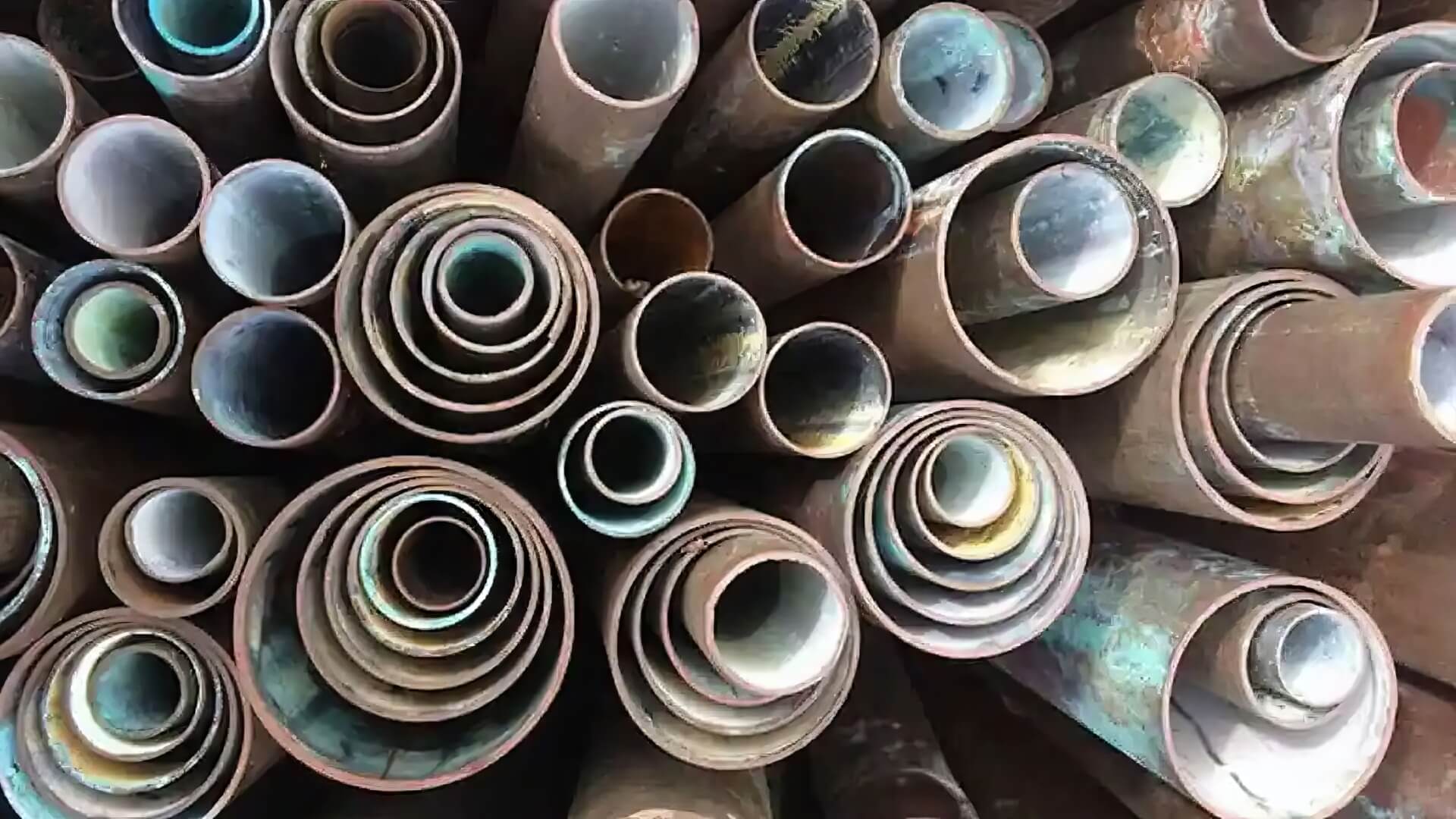
10 Signs Your Hot Water Heater Will Fail
If your water heater is old, leaking, rusty, noisy, not heating water properly or has low pressure, it could fail soon. Get your hot water system inspected today.
Read MoreChoosing pipe materials involves considering their properties, applications, and common usage in Australia. The most common include copper, galvanised steel, cast iron, PEX and PVC.
Copper pipes are a steadfast choice, prized for their availability, durability, and effective corrosion resistance. Copper’s malleability eases installation. Despite this, they can be costly and susceptible to pinhole leaks as they age.
Galvanised steel pipes are affordable, sturdy and handle high water pressure well. However, they may corrode over time and lack the flexibility of alternatives during installation.
Cast iron pipes are nearly indestructible, affordable and noise dampening. Their downsides include heaviness, possible internal corrosion, and poor performance in freezing conditions.
PEX pipe (or cross-linked polyethylene) is known for its flexibility, freeze resistance and cost-efficiency. Yet, PEX pipes falter under UV light and high temperatures compared to their metal counterparts.
PVC pipes are affordable, easy to install, durable and handle chemicals well. Their drawbacks include potential brittleness over time and inefficient heat conduction.
In emergencies such as freezing winters or fire damage, material choices are critical. Adequate insulation is crucial for enhancing pipe resilience in emergencies. For informed decisions, understanding each material’s pros and cons is essential.
When it comes to plastic pipes for plumbing, PVC and PEX piping represent two of the one most frequently chosen options in modern plumbing.
PVC pipes are cost-effective and robust, ideal for chemically aggressive environments. They manage liquid well but are prone to brittleness with age. It’s also noteworthy that while PVC has limitations in heat conduction, it is not appropriate for hot water applications due to the risk of warping.
PEX pipes are applauded for their flexibility, tolerance to freezing conditions, and affordability.
Their capacity to endure varying temperatures renders them adaptable for diverse plumbing applications. PEX pipes, widely recognised in the United States for their innovation, limit the risk of pinhole leaks that copper is prone to.
Although both have advantages and disadvantages, PEX trumps in handling temperature fluctuations without losing elasticity.
When it comes to emergency resilience, however, PEX typically outperforms PVC. It’s important to ensure proper installation and insulation for all plastic pipes to avert weather-related complications.
PVC (polyvinyl chloride) is a popular plastic piping material in plumbing systems. It offers many benefits:
However, PVC has some downsides to consider:
PVC’s brittleness under freezing conditions makes it vulnerable to cracking in such emergencies. Proper insulation is key to prevent issues. While very cost-effective, PVC has limitations depending on the plumbing application.
PEX (cross-linked polyethylene) piping has gained immense popularity in recent years due to its highly useful properties:
The flexibility and freeze-resistance of PEX make it well-suited for regions with extreme winter temperatures. Proper insulation is still vital, but PEX gives plumbers an advantage over other materials with one less point of failure to worry about.
PEX remains resilient, unyielding to brittleness and cracking, and its resistance to pinhole leaks inspires trust.
PEX merits attention for emergency situations, thanks to its reliable and robust nature.
Metal pipes like copper and galvanised steel have a long history of use in plumbing systems. They offer durability and longevity when installed properly.
Copper in particular enjoys immense popularity due to its corrosion resistance, ease of installation, and ability to withstand high water pressure. However, copper pipes are prone to freezing and bursting in cold temperatures.
Galvanised steel piping is affordable and highly durable. But over time, it may corrode internally which can cause water flow issues. Galvanised steel also doesn’t handle hot liquids very well compared to copper.
In emergency situations, both copper and galvanised steel are vulnerable to cracks and bursts if water inside freezes and expands. Proper insulation is critical. Weighing cost against longevity is important when deciding between metal piping options.
Galvanised steel pipes have a zinc coating applied to standard steel piping. This galvanization gives an extra layer of corrosion protection. The zinc reacts with the water supply and oxygen to form a protective layer that insulates the underlying steel.
Galvanised steel, used in residential and commercial plumbing, is favored for its affordability and robustness under high water pressures. Galvanised steel is apt for demanding water flow rates due to its rigidity.
However, there are some downsides to consider.
Galvanised steel may still succumb to internal corrosion, resulting in buildup and rust. Additionally, the zinc coating renders galvanised pipes inappropriate for transporting drinking water.
In emergency situations like freezing winters, galvanised steel faces the same risks as other metal pipes. The rigid structure allows cracks and bursts if ice forms and expands internally. Insulation and heat tracing on pipes can help prevent this scenario.
Overall, galvanised steel offers durability at a lower cost but requires more maintenance than copper or plastic piping in the long run. Its susceptibility to internal rusting also limits applications to non-potable uses in most plumbing systems.
Copper has traditionally been the most popular piping material used in plumbing systems. This is thanks to copper’s natural corrosion resistance, longevity, and efficient heat conduction.
Copper pipe handles water pressure fluctuations efficiently and offers ease of installation for experienced plumbers. However, the costs for copper can add up, being more expensive upfront compared to other piping materials.
In emergency situations, copper faces a higher risk of freezing and bursting during cold weather spells. This is due to copper’s rigid structure - when water freezes and expands inside, copper pipes can crack open.
Proper insulation is key for copper pipes in cold climates. Heat tracing along the pipe length can also prevent freezing. Weighing cost against lifetime value is important when deciding whether to use copper.
When disaster strikes, you want pipes that can withstand the pressure. What do you do in the throes of a plumbing crisis? Assessing the resilience of different materials against freezing temperatures or a raging fire is vital.
Copper pipes, for instance, are also suitable for maintaining high water pressure and handling temperature fluctuations. However, they are susceptible to freezing and bursting in cold conditions. Proper insulation is essential for prevention.
Galvanised steel pipes are affordable and durable, handling high pressures well. But they can corrode internally over time and may not be suitable for hot water applications.
Cast iron pipes are nearly indestructible but can corrode internally and don’t withstand freezing temperatures.
Plastic pipes, such as PVC and PEX, offer advantages like affordability, ease of installation, and resistance to chemicals. When choosing to use PEX pipes, homeowners benefit from their flexibility, freeze resistance, and ability to accommodate freezing water without bursting.
Concrete pipes, uncommon in residences but fire-resistant, are optimal for fire-prone commercial or industrial settings.
In emergency plumbing, knowing each material’s strengths and weaknesses informs repair or replacement decisions. When selecting pipes, you’ll need to know and thus consider factors like cost, longevity, and performance under stress for your home or business.
Of all the potential emergencies that can befall your plumbing system, freezing temperatures are among the most damaging. When the mercury drops, your pipes can be at serious risk.
Materials like PEX are particularly beneficial in these conditions thanks to their impressive freeze resistance. PEX pipes are flexible and can expand to accommodate freezing water, reducing the risk of cracks or bursts. This makes PEX an excellent choice for regions that experience extreme winters.
Copper pipes, on the other hand, are more vulnerable to freezing temperatures. While copper is naturally corrosion-resistant and handles water pressure fluctuations well, its rigid structure leaves it prone to bursting when water inside freezes and expands.
Galvanised steel pipes also face the same risks as copper in freezing conditions. The rigidity of galvanised steel allows cracks and bursts if ice forms and expands internally.
When it comes to emergency resilience, knowing the strengths and limitations of each pipe material is essential. For coping with freezing temperatures, PEX pipes offer a reliable and durable solution. When it comes to pipe fitting, proper installation and insulation are vital, regardless of the material chosen.
Fires and extreme heat can wreak havoc on plumbing systems, damaging pipes and fittings. Not all materials are created equal when it comes to high temperature resilience.
Plastic pipes like PVC and PEX don’t withstand fire or extreme heat very well. PVC and PEX pipes also release toxic fumes when burned so they pose health dangers in a fire.
At high enough temperatures, These pipes may melt, deform, or ignite. This can lead to leaks and water damage once the pipes fail.
Metal pipes, such as copper and galvanised steel, offer better resistance to suitable high temperature scenarios but are not immune to the effects of extreme heat. Sustained heat exposure causes the materials to weaken and deform. Insulation will slow this process but may not prevent failure.
Cast iron pipes, suitable for high temperature contexts, join concrete pipes as intrinsically more fire-resistant. Their sturdy material composition allows them to withstand heat and flame better than plastic or other metals before integrity loss occurs. Concrete pipes in particular are inherently fireproof.
Fire-resistant piping in emergencies can protect life and property. Damage may still occur but more heat-tolerant materials will fail slower. Proper installation per code regulations combined with adequate insulation gives piping the best chance of surviving the intense conditions.
When it comes to preventing plumbing emergencies, proper installation and insulation of pipes are crucial first steps. Understanding your local climate and choosing pipe materials accordingly is key.
In cold regions prone to freezing temperatures, flexible pipes like PEX that can expand without bursting are ideal. Proper insulation with heating cables can also prevent frozen and cracked pipes.
In hot climates, materials like PEX and copper that can withstand high temps are preferred. Ensure insulation meets code ratings for maximum heat protection.
The connections and fittings used when installing pipes also impact resilience. Choose fittings meant for the specific pipe type that form secure joins less likely to separate under stress.
Work with professional plumbers like those at Mortdale Plumbing to select the right materials and fittings for your home’s needs. Keeping pipes properly maintained via checks for leaks, bursts and obstruction buildup can also prevent larger emergencies down the road.
Don’t wait for disaster to strike. With preventative maintenance and proactive material selection, we’re here to strengthen your plumbing system against the unpredictable forces of nature.
For expert advice tailored to your home, contact our team today on 1300 349 338 or email jobs@mortdaleplumbingservices.com.au.
If your water heater is old, leaking, rusty, noisy, not heating water properly or has low pressure, it could fail soon. Get your hot water system inspected today.
Read MoreIf you have plumbing fixtures that are over 10 years old or showing signs of wear like leaks and cracks, it’s important to replace them to prevent more costly water damage in the future. Replacing worn fixtures improves water efficiency.
Read MorePipe relining is a trenchless method that renews pipes from the inside out. It involves draining, drying and scrubbing the pipe interiors before applying materials like silicone, PMMA or epoxy resins to create a resilient, soft, temporary liner inside the existing pipes.
Read MoreMortdale, 2223 NSW
We will call back as soon as possible.




